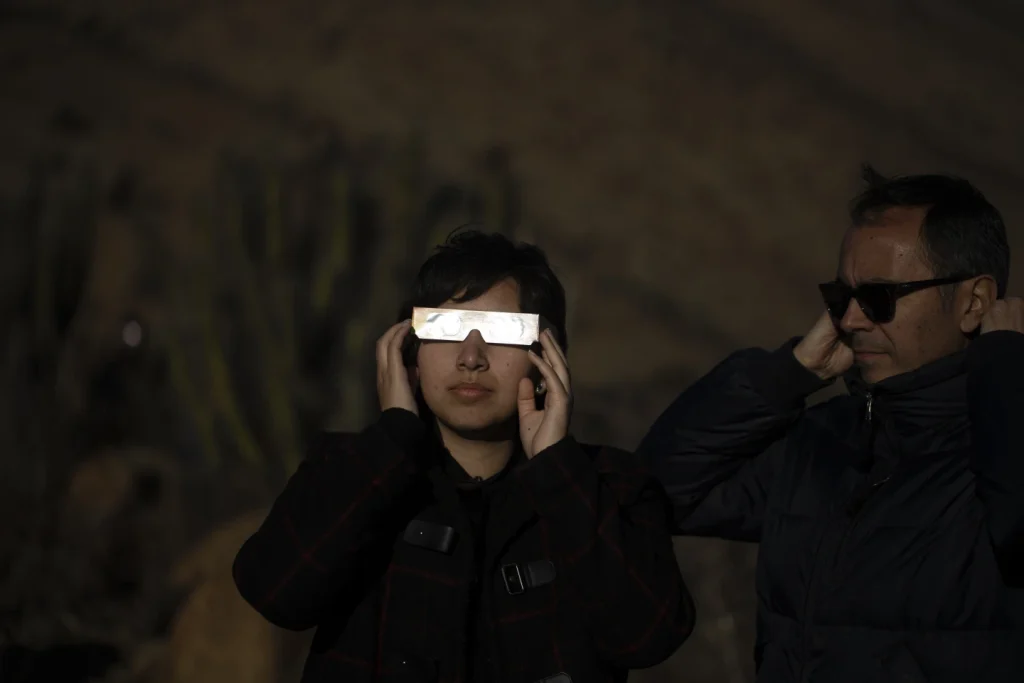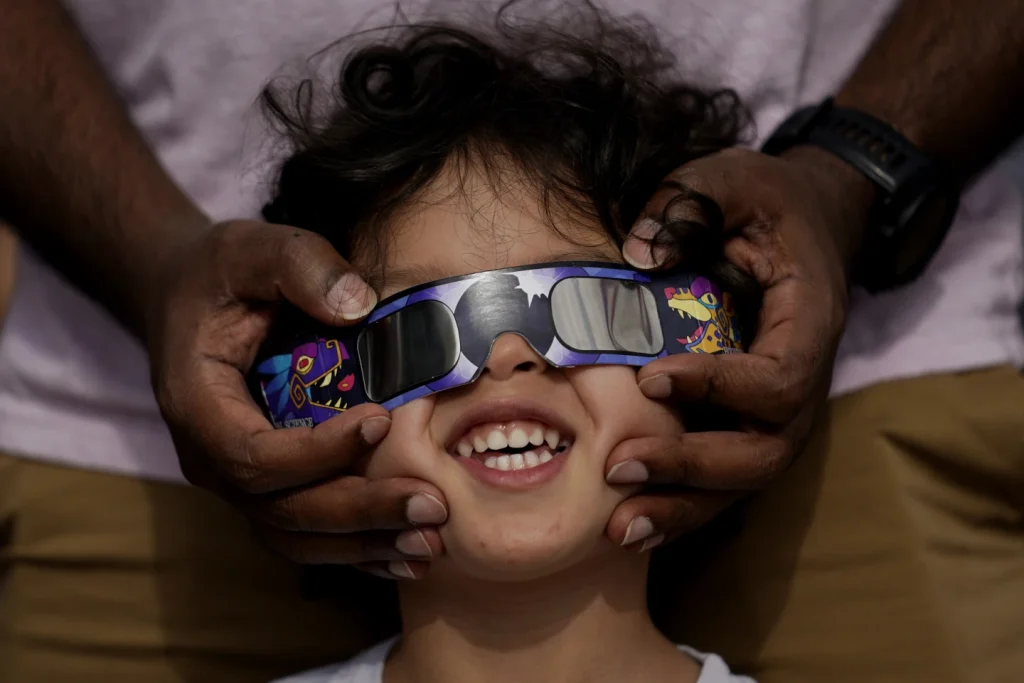The anticipation surrounding Monday’s total solar eclipse is palpable, with many experts predicting that it could potentially become one of the most extensively filmed and photographed events of the year.
As the moon gracefully moves in front of the sun, casting a shadow over a significant portion of North America and briefly shrouding it in darkness, countless individuals will be eager to capture this celestial spectacle through the lens of their cameras or smartphones.
However, the unique challenges posed by the intense solar rays and the rapid changes in lighting conditions make capturing that perfect image a task that requires careful planning and preparation.
One of the crucial considerations for anyone aiming to document the eclipse is finding the optimal location to witness and capture this extraordinary phenomenon.
Being in the right position is essential, and ideally, one should strive to be as close as possible to the path of totality. This path stretches from Mexico’s Pacific coast and culminates in eastern Canada, encompassing fifteen U.S. states that will experience the full eclipse.
Online maps, such as those provided by NASA, offer valuable insights into the duration of totality at specific locations within the path, as well as the extent of the partial eclipse visible outside of it.
Eclipse expert Xavier Jubier’s website further enhances this experience by overlaying the eclipse’s trajectory on Google Maps, allowing users to explore street-level details and plan their viewing locations meticulously.
Adapting to the unpredictable nature of weather conditions is another crucial aspect to consider when preparing to capture the eclipse.
Utilizing weather forecast tools and cloud coverage apps, such as those offered by the National Weather Service and Astrospheric, can help individuals identify locations with clearer skies and maximize their chances of witnessing the event in all its glory.
Monitoring these resources on the morning of the eclipse or even a day prior can provide valuable insights that may influence the choice of the shooting location.
Planning a successful shot during the eclipse involves a myriad of factors, including cloud cover and the sun’s position in the sky.
To aid eclipse enthusiasts in this endeavor, a plethora of smartphone apps tailored for eclipse chasers have been developed.
The American Astronomical Society has curated a selection of these apps for both iOS and Android devices, with offerings like the Totality app, which displays your location on a map of the totality path.
The Solar Eclipse Timer app leverages your phone’s GPS capabilities to provide an audio countdown to the moment of totality and highlight key events during the eclipse. Users are advised to use a separate device for capturing photos to avoid missing any crucial moments.
For Android users, the Eclipse Calculator 2 app utilizes the phone’s camera to simulate how the eclipse will appear in the sky from the user’s position, overlaying lines on the camera image for enhanced visualization.
iPhone users can explore apps such as Sky Guide and SkySafari, which feature eclipse simulators to enhance the viewing experience.
While there are other iOS apps that incorporate augmented reality to simulate the eclipse, these options tend to be pricier and may not yet be included in the American Astronomical Society’s recommended list.
In conclusion, the upcoming total solar eclipse presents a remarkable opportunity for both seasoned photographers and amateur enthusiasts to capture a breathtaking moment in nature.
By carefully selecting the optimal viewing location, staying abreast of weather conditions, and leveraging the myriad of smartphone apps available for eclipse photography, individuals can increase their chances of obtaining stunning images that encapsulate the beauty and grandeur of this celestial event.
As Monday approaches, let us prepare to witness and document a spectacle that transcends the ordinary and reminds us of the awe-inspiring wonders of the universe.
The allure of a celestial event such as a solar eclipse prompts many to try and capture its beauty through photography. The challenge lies in not only understanding the technical aspects of photography but also in ensuring the safety of oneself and the equipment involved.
Whether equipped with a high-end DSLR camera or a trusty smartphone, there are key considerations and techniques to employ in order to take a great photo of the eclipse.
For those wielding a Digital SLR camera, the possibilities for capturing stunning eclipse photos are vast. The manual exposure controls inherent in these cameras allow for precise adjustments, crucial for achieving optimal results.
Adding zoom lenses and accessories like remote shutter buttons can further enhance the photographic capabilities, enabling photographers to create exceptional images.
Renowned photographer Julio Cortez recommends using a smaller aperture, typically around f11 or f17, to maintain sharp focus. Additionally, setting the ISO to 1250 and using a shutter speed of 1/500 can produce remarkable results, as evidenced by Cortez’s work during the 2017 total solar eclipse.
However, not everyone may have access to a DSLR camera. For the majority who rely on smartphones for photography, there are still ways to capture the eclipse effectively.
While smartphones may not be designed specifically for sun and moon photography, advancements in technology have equipped newer models with sophisticated sensors, multiple lenses, and image stabilization software that can significantly improve the chances of success.
Utilizing features like HDR mode, which blends images taken at different light levels, can help capture the varying intensity of light during an eclipse.
When it comes to protecting equipment against the sun’s intense rays, precautions are essential. The American Astronomical Society recommends using solar filters to shield cameras from sunlight and heat.
While filters designed for DSLR lenses are available for purchase, creating a makeshift filter using cardboard, tinted film, and fasteners can offer a quick and effective solution.
Smartphone users can opt for eclipse glasses held over the lens or invest in a smartphone filter, ensuring that macro mode is disabled to prevent damage.
For prolonged photography sessions, using a tripod is advisable to maintain stability and avoid camera shake. Aligning the camera accurately can be facilitated by using a solar finder, a tool that aids in locating the sun without risking eye damage.

To prevent equipment from overheating while waiting for the eclipse, covering it with a white towel is a practical suggestion put forth by Cortez.
The temptation to capture a selfie with the eclipse is understandable, given the social media age we live in. However, caution must be exercised to protect one’s vision.
The screen of a smartphone reflecting harmful ultraviolet light poses a risk, even if the sun is not directly viewed. Using a solar filter on the selfie camera may result in a dark image where the subject is not visible, highlighting the importance of safety over social media aesthetics.
In conclusion, whether armed with a DSLR camera or a smartphone, capturing the eclipse through photography requires a blend of technical know-how, safety precautions, and creative flair.
By following expert advice, utilizing the right equipment, and prioritizing safety, photographers can immortalize the awe-inspiring spectacle of a solar eclipse through captivating images that stand the test of time.
